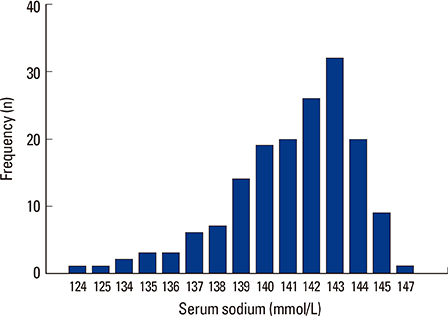J Bone Metab.
2015 Feb;22(1):9-15. 10.11005/jbm.2015.22.1.9.
Relationship between Decrease in Serum Sodium Level and Bone Mineral Density in Osteoporotic Fracture Patients
- Affiliations
-
- 1Departement of Internal Medicine, Soonchunhyang University Hospital, Soonchunhyang University College of Medicine, Seoul, Korea. byundw@schmc.ac.kr
- KMID: 2170059
- DOI: http://doi.org/10.11005/jbm.2015.22.1.9
Abstract
- BACKGROUND
Recently, it has been suggested that decrease in serum sodium level is associated with osteoporosis. However, no study in Korea has reported the association of decrease in serum sodium level with osteoporosis. In this study, we investigated the relationship between the decrease in serum sodium level and severity of osteoporotic fracture in patients.
METHODS
We enrolled 290 subjects who were admitted and operated at Soonchunhyang University Hospital due to major fractures. For the control group, we enrolled 1,027 subjects who visited a health promotion center. We carried a 1:1 matching with age and sex from the case group.
RESULTS
In a total of 164 age- and sex-matched subjects, serum sodium level was significantly lower in the fracture group than in the non-fracture group (P=0.001). Serum sodium level was significantly lower in the severe osteoporosis group than that in the non-severe osteoporosis group (P=0.002). Old age and decrease in serum sodium level were independent risk factors of osteoporosis (odds ratio [OR]=1.088, P=0.008, confidence interval [CI]=[1.022-1.157]; OR= 0.840, P=0.037, CI=0.713-0.989).
CONCLUSIONS
Serum sodium level was significantly lower in the fracture group than that in the non-fracture group and in the severe osteoporosis group than that in the non-severe osteoporosis group. Based on our results, the decrease in serum sodium level could be an independent risk factor for osteoporosis.
Keyword
MeSH Terms
Figure
Reference
-
1. Carriero FP, Christmas C. In the clinic. Hip fracture. Ann Intern Med. 2011; 155:ITC6-1–ITC6-15.2. Hannan EL, Magaziner J, Wang JJ, et al. Mortality and locomotion 6 months after hospitalization for hip fracture: risk factors and risk-adjusted hospital outcomes. JAMA. 2001; 285:2736–2742.
Article3. Upadhyay A, Jaber BL, Madias NE. Incidence and prevalence of hyponatremia. Am J Med. 2006; 119:S30–S35.
Article4. Hawkins RC. Age and gender as risk factors for hyponatremia and hypernatremia. Clin Chim Acta. 2003; 337:169–172.
Article5. Kinsella S, Moran S, Sullivan MO, et al. Hyponatremia independent of osteoporosis is associated with fracture occurrence. Clin J Am Soc Nephrol. 2010; 5:275–280.
Article6. Hagino T, Ochiai S, Watanabe Y, et al. Hyponatremia at admission is associated with in-hospital death in patients with hip fracture. Arch Orthop Trauma Surg. 2013; 133:507–511.
Article7. Ayus JC, Negri AL, Kalantar-Zadeh K, et al. Is chronic hyponatremia a novel risk factor for hip fracture in the elderly? Nephrol Dial Transplant. 2012; 27:3725–3731.
Article8. Hoorn EJ, Liamis G, Zietse R, et al. Hyponatremia and bone: an emerging relationship. Nat Rev Endocrinol. 2012; 8:33–39.
Article9. Park SM, Jee J, Joung JY, et al. High Dietary Sodium Intake Assessed by 24-hour Urine Specimen Increase Urinary Calcium Excretion and Bone Resorption Marker. J Bone Metab. 2014; 21:189–194.
Article10. Sanders KM, Pasco JA, Ugoni AM, et al. The exclusion of high trauma fractures may underestimate the prevalence of bone fragility fractures in the community: the Geelong Osteoporosis Study. J Bone Miner Res. 1998; 13:1337–1342.
Article11. Heo YM, Yi JW, Kim KK, et al. The incidence of osteoporosis and the related factors among injured sites in above 50 year-old patients with fractures caused by low-energy trauma. Osteoporosis. 2013; 11:126–135.12. World Health Organization Study Group. Assessment of fracture risk and its application to screening for postmenopausal osteoporosis. Report of a WHO Study Group. World Health Organ Tech Rep Ser. 1994; 843:1–129.13. Sandhu HS, Gilles E, DeVita MV, et al. Hyponatremia associated with large-bone fracture in elderly patients. Int Urol Nephrol. 2009; 41:733–737.
Article14. Tzamaloukas AH, Malhotra D, Rosen BH, et al. Principles of management of severe hyponatremia. J Am Heart Assoc. 2013; 2:e005199.
Article15. Cummings SR, Melton LJ. Epidemiology and outcomes of osteoporotic fractures. Lancet. 2002; 359:1761–1767.
Article16. Hong S, Choi WH. Osteoporosis and decrease in bone mineral density have associated with the reduced quality of life. Osteoporosis. 2011; 9:175–179.17. Burge R, Dawson-Hughes B, Solomon DH, et al. Incidence and economic burden of osteoporosis-related fractures in the United States, 2005-2025. J Bone Miner Res. 2007; 22:465–475.
Article18. Kumar S, Berl T. Sodium. Lancet. 1998; 352:220–228.
Article19. Siris ES, Miller PD, Barrett-Connor E, et al. Identification and fracture outcomes of undiagnosed low bone mineral density in postmenopausal women: results from the National Osteoporosis Risk Assessment. JAMA. 2001; 286:2815–2822.
Article
- Full Text Links
- Actions
-
Cited
- CITED
-
- Close
- Share
- Similar articles
-
- Diffrences of Bone Mineral Density between Osteoporotic Group with or without Compression Fracture of the Spine
- Osteoporotic Spinal Compression Fracture and Degree of Vitamin D Deficiency
- Measurement of bone mineral density in osteoporotic fracture of the spine using dual energy X-ray absorptiometry
- Measurement of bone mineral density in osteoporotic fracture of the proximal femur using dual energy x-ray absorptiometry
- Trabecular Bone Score as a Risk Factor of Major Osteoporotic Fracture in Postmenopausal Women: The First Study in Thailand




